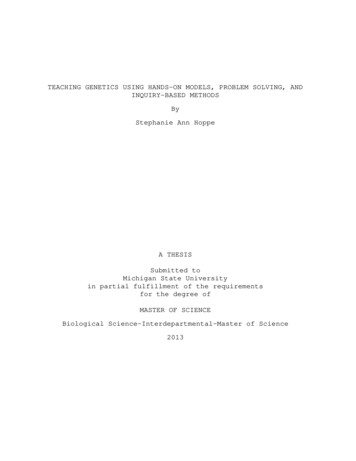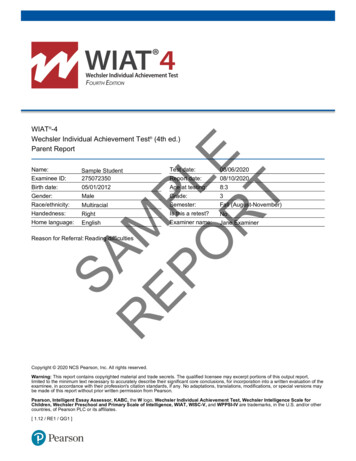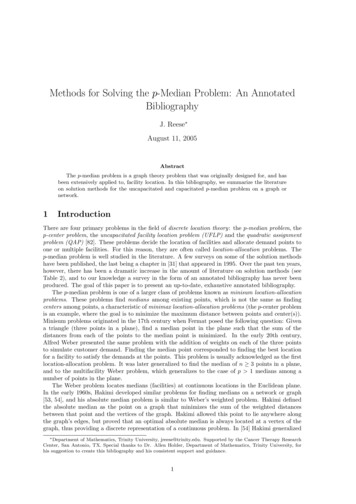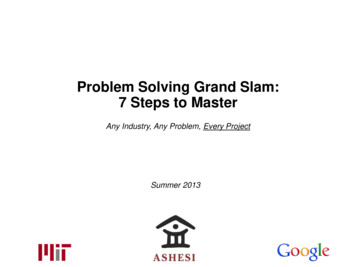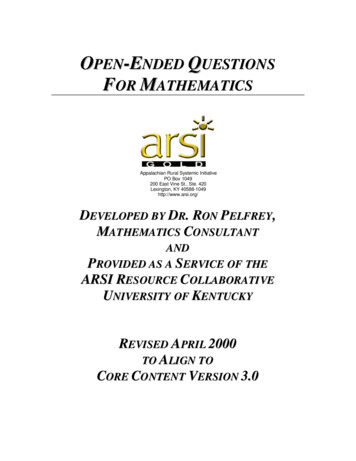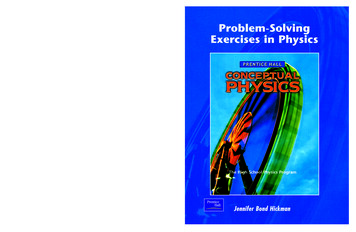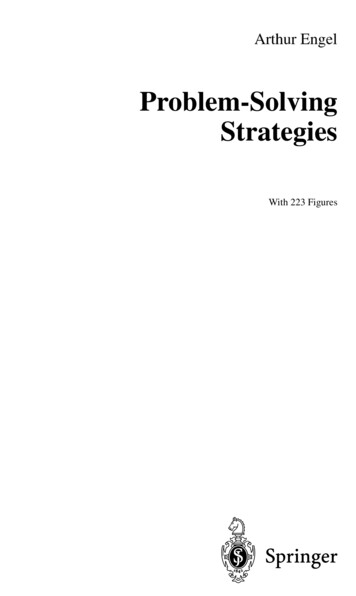
Transcription
A-PDF Merger DEMO : Purchase from www.A-PDF.comto remoArthur EngelProblem-SolvingStrategiesWith 223 Figures13
Angel EngelInstitut für Didaktik der MathematikJohann Wolfgang Goethe–Universität Frankfurt am MainSenckenberganlage 9–1160054 Frankfurt am Main 11GermanySeries Editor:Paul R. HalmosDepartment of MathematicsSanta Clara UniversitySanta Clara, CA 95053USAMathematics Subject Classification (1991): 00A07Library of Congress Cataloging-in-Publication DataEngel, Arthur.Problem-solving strategies/Arthur Engel.p. cm. — (Problem books in mathematics)Includes index.ISBN 0-387-98219-1 (softcover: alk. paper)1. Problem solving. I. Title. II. Series.QA63.E54 199797-10090510 .76—dc21 1998 Springer-Verlag New York, Inc.All rights reserved. This work may not be translated or copied in whole or in part without the writtenpermission of the publisher (Springer-Verlag New York, Inc., 175 Fifth Avenue, New York, NY 10010,USA), except for brief excerpts in connection with reviews or scholarly analysis. Use in connectionwith any form of information storage and retrieval, electronic adaptation, computer software, or bysimilar or dissimilar methodology now known or hereafter developed is forbidden.The use of general descriptive names, trade names, trademarks, etc., in this publication, even if theformer are not especially identified, is not to be taken as a sign that such names, as understood by theTrade Marks and Merchandise Marks Act, may accordinly be used freely by anyone.ISBN 0–387–98219–1 Springer-Verlag New York Berlin HeidelburgSPIN 10557554
PrefaceThis book is an outgrowth of the training of the German IMO team from a timewhen we had only a short training time of 14 days, including 6 half-day tests. Thishas forced upon us a training of enormous compactness. “Great Ideas” were theleading principles. A huge number of problems were selected to illustrate theseprinciples. Not only topics but also ideas were efficient means of classification.For whom is this book written? For trainers and participants of contests of all kinds up to the highest level ofinternational competitions, including the IMO and the Putnam Competition. For the regular high school teacher, who is conducting a mathematics cluband is looking for ideas and problems for his/her club. Here, he/she will findproblems of any level from very simple ones to the most difficult problemsever proposed at any competition. For high school teachers who want to pose the problem of the week, problemof the month, and research problems of the year. This is not so easy. Many fail,but some persevere, and after a while they succeed and generate a creativeatmosphere with continuous discussions of mathematical problems. For the regular high school teacher, who is just looking for ideas to enrichhis/her teaching by some interesting nonroutine problems. For all those who are interested in solving tough and interesting problems.The book is organized into chapters. Each chapter starts with typical examplesillustrating the main ideas followed by many problems and their solutions. The
viPrefacesolutions are sometimes just hints, giving away the main idea leading to the solution. In this way, it was possible to increase the number of examples and problemsto over 1300. The reader can increase the effectiveness of the book even more bytrying to solve the examples.The problems are almost exclusively competition problems from all over theworld. Most of them are from the former USSR, some from Hungary, and somefrom Western countries, especially from the German National Competition. Thecompetition problems are usually variations of problems from journals with problem sections. So it is not always easy to give credit to the originators of the problem.If you see a beautiful problem, you first wonder at the creativity of the problemproposer. Later you discover the result in an earlier source. For this reason, thereferences to competitions are somewhat sporadic. Usually no source is given if Ihave known the problem for more than 25 years. Anyway, most of the problemsare results that are known to experts in the respective fields.There is a huge literature of mathematical problems. But, as a trainer, I knowthat there can never be enough problems. You are always in desperate need of newproblems or old problems with new solutions. Any new problem book has somenew problems, and a big book, as this one, usually has quite a few problems thatare new to the reader.The problems are arranged in no particular order, and especially not in increasingorder of difficulty. We do not know how to rate a problem’s difficulty. Even the IMOjury, now consisting of 75 highly skilled problem solvers, commits grave errorsin rating the difficulty of the problems it selects. The over 400 IMO contestantsare also an unreliable guide. Too much depends on the previous training by anever-changing set of hundreds of trainers. A problem changes from impossible totrivial if a related problem was solved in training.I would like to thank Dr. Manfred Grathwohl for his help in implementingvarious LaTEX versions on the workstation at the institute and on my PC at home.When difficulties arose, he was a competent and friendly advisor.There will be some errors in the proofs, for which I take full responsibility,since none of my colleagues has read the manuscript before. Readers will missimportant strategies. So do I, but I have set myself a limit to the size of the book.Especially, advanced methods are missing. Still, it is probably the most completetraining book on the market. The gravest gap is the absence of new topics likeprobability and algorithmics to counter the conservative mood of the IMO jury.One exception is Chapter 13 on games, a topic almost nonexistent in the IMO, butvery popular in Russia.Frankfurt am Main, GermanyArthur Engel
ContentsPreface . . . . . . . . . . . . . . . . . . . . . . . . . . . . . . . . . . . . . . . . . . . . . . . . . . . . . . . . . . . .vAbbreviations and Notations . . . . . . . . . . . . . . . . . . . . . . . . . . . . . . . . . . . . . . . . .ix1The Invariance Principle. . . . . . . . . . . . . . . . . . . . . . . . . . . . . . . . . . . . . . . . . .12Coloring Proofs . . . . . . . . . . . . . . . . . . . . . . . . . . . . . . . . . . . . . . . . . . . . . . . . .253The Extremal Principle . . . . . . . . . . . . . . . . . . . . . . . . . . . . . . . . . . . . . . . . . . .394The Box Principle . . . . . . . . . . . . . . . . . . . . . . . . . . . . . . . . . . . . . . . . . . . . . . .595Enumerative Combinatorics . . . . . . . . . . . . . . . . . . . . . . . . . . . . . . . . . . . . . .856Number Theory . . . . . . . . . . . . . . . . . . . . . . . . . . . . . . . . . . . . . . . . . . . . . . . . .1177Inequalities . . . . . . . . . . . . . . . . . . . . . . . . . . . . . . . . . . . . . . . . . . . . . . . . . . . . .1618The Induction Principle . . . . . . . . . . . . . . . . . . . . . . . . . . . . . . . . . . . . . . . . . .2059Sequences . . . . . . . . . . . . . . . . . . . . . . . . . . . . . . . . . . . . . . . . . . . . . . . . . . . . . .22110 Polynomials . . . . . . . . . . . . . . . . . . . . . . . . . . . . . . . . . . . . . . . . . . . . . . . . . . . .24511 Functional Equations . . . . . . . . . . . . . . . . . . . . . . . . . . . . . . . . . . . . . . . . . . . .271
viiiContents12 Geometry . . . . . . . . . . . . . . . . . . . . . . . . . . . . . . . . . . . . . . . . . . . . . . . . . . . . . . .28913 Games. . . . . . . . . . . . . . . . . . . . . . . . . . . . . . . . . . . . . . . . . . . . . . . . . . . . . . . . . .36114 Further Strategies . . . . . . . . . . . . . . . . . . . . . . . . . . . . . . . . . . . . . . . . . . . . . . . .373References . . . . . . . . . . . . . . . . . . . . . . . . . . . . . . . . . . . . . . . . . . . . . . . . . . . . . . . . .397Index . . . . . . . . . . . . . . . . . . . . . . . . . . . . . . . . . . . . . . . . . . . . . . . . . . . . . . . . . . . . . .401
Abbreviations and NotationsAbbreviationsARO Allrussian Mathematical OlympiadATMO Austrian Mathematical OlympiadAuMO Australian Mathematical OlympiadAUO Allunion Mathematical OlympiadBrMO British Mathematical OlympiadBWM German National OlympiadBMO Balkan Mathematical OlympiadChNO Chinese National OlympiadHMO Hungarian Mathematical Olympiad (Kűrschak Competition)IIM International Intellectual Marathon (Mathematics/Physics Competition)IMO International Mathematical OlympiadLMO Leningrad Mathematical OlympiadMMO Moskov Mathematical OlympiadPAMO Polish-Austrian Mathematical Olympiad
xAbbreviations and NotationsPMO Polish Mathematical OlympiadRO Russian Olympiad (ARO from 1994 on)SPMO St. Petersburg Mathematical OlympiadTT Tournament of the TownsUSO US OlympiadNotations for Numerical SetsN or Z the positive integers (natural numbers), i.e., {1,2,3, . . . }N0 the nonnegative integers, {0,1,2, . . . }Z the integersQ the rational numbersQ the positive rational numbersQ 0 the nonnegative rational numbersR the real numbersR the positive real numbersC the complex numbersZn the integers modulo n1 . . n the integers 1, 2, . . . , nNotations from Sets, Logic, and Geometry iff, if and only if impliesA B A is a subset of BA \ B A without BA B the intersection of A and BA B the union of A and Ba A the element a belongs to the set A AB also AB, the distance between the points A and Bbox parallelepiped, solid bounded by three pairs of parallel planes
1The Invariance PrincipleWe present our first Higher Problem-Solving Strategy. It is extremely useful insolving certain types of difficult problems, which are easily recognizable. We willteach it by solving problems which use this strategy. In fact, problem solvingcan be learned only by solving problems. But it must be supported by strategiesprovided by the trainer.Our first strategy is the search for invariants, and it is called the Invariance Principle. The principle is applicable to algorithms (games, transformations). Sometask is repeatedly performed. What stays the same? What remains invariant?Here is a saying easy to remember:If there is repetition, look for what does not change!In algorithms there is a starting state S and a sequence of legal steps (moves,transformations). One looks for answers to the following questions:1. Can a given end state be reached?2. Find all reachable end states.3. Is there convergence to an end state?4. Find all periods with or without tails, if any.Since the Invariance Principle is a heuristic principle, it is best learned by experience, which we will gain by solving the key examples E1 to E10.
21. The Invariance PrincipleE1. Starting with a point S (a, b) of the plane with 0 b a, we generate asequence of points (xn , yn ) according to the rulex0 a,y0 b,xn 1 xn yn,2yn 1 2xn yn.xn ynHere it is easy to find an invariant. From xn 1 yn 1 xn yn , for all n we deducexn yn ab for all n. This is the invariant we are looking for. Initially, we havey0 x0 . This relation also remains invariant. Indeed, suppose yn xn for somen. Then xn 1 is the midpoint of the segment with endpoints yn , xn . Moreover,yn 1 xn 1 since the harmonic mean is strictly less than the arithmetic mean.Thus,xn ynxn yn xn yn ·0 xn 1 yn 1 xn yn22 for all n. So we have lim xn lim yn x with x 2 ab or x ab.Here the invariant helped us very much, but its recognition was not yet thesolution, although the completion of the solution was trivial.E2. Suppose the positive integer n is odd. First Al writes the numbers 1, 2, . . . , 2non the blackboard. Then he picks any two numbers a, b, erases them, and writes,instead, a b . Prove that an odd number will remain at the end.Solution. Suppose S is the sum of all the numbers still on the blackboard. Initiallythis sum is S 1 2 · · · 2n n(2n 1), an odd number. Each step reduces Sby 2 min(a, b), which is an even number. So the parity of S is an invariant. Duringthe whole reduction process we have S 1 mod 2. Initially the parity is odd. So,it will also be odd at the end.E3. A circle is divided into six sectors. Then the numbers 1, 0, 1, 0, 0, 0 are written into the sectors (counterclockwise, say). You may increase two neighboringnumbers by 1. Is it possible to equalize all numbers by a sequence of such steps?Solution. Suppose a1 , . . . , a6 are the numbers currently on the sectors. Then I a1 a2 a3 a4 a5 a6 is an invariant. Initially I 2. The goal I 0 cannotbe reached.E4. In the Parliament of Sikinia, each member has at most three enemies. Provethat the house can be separated into two houses, so that each member has at mostone enemy in his own house.Solution. Initially, we separate the members in any way into the two houses. LetH be the total sum of all the enemies each member has in his own house. Nowsuppose A has at least two enemies in his own house. Then he has at most oneenemy in the other house. If A switches houses, the number H will decrease. Thisdecrease cannot go on forever. At some time, H reaches its absolute minimum.Then we have reached the required distribution.
1. The Invariance Principle3Here we have a new idea. We construct a positive integral function which decreases at each step of the algorithm. So we know that our algorithm will terminate. There is no strictly decreasing infinite sequence of positive integers. H is notstrictly an invariant, but decreases monotonically until it becomes constant. Here,the monotonicity relation is the invariant.E5. Suppose not all four integers a, b, c, d are equal. Start with (a, b, c, d) andrepeatedly replace (a, b, c, d) by (a b, b c, c d, d a). Then at least onenumber of the quadruple will eventually become arbitrarily large.Solution. Let Pn (an , bn , cn , dn ) be the quadruple after n iterations. Then wehave an bn cn dn 0 for n 1. We do not see yet how to use this invariant.But geometric interpretation is mostly helpful. A very important function for thepoint Pn in 4-space is the square of its distance from the origin (0, 0, 0, 0), whichis an2 bn2 cn2 dn2 . If we could prove that it has no upper bound, we would befinished.We try to find a relation between Pn 1 and Pn :2222an 1 bn 1 cn 1 dn 1 (an bn )2 (bn cn )2 (cn dn )2 (dn an )2 2(an2 bn2 cn2 dn2 ) 2an bn 2bn cn 2cn dn 2dn an .Now we can use an bn cn dn 0 or rather its square:0 (an bn cn dn )2 (an cn )2 (bn dn )2 2an bn 2an dn 2bn cn 2cn dn .(1)2222 bn 1 cn 1 dn 1, we getAdding (1) and (2), for an 12(an2 bn2 cn2 dn2 ) (an cn )2 (bn dn )2 2(an2 bn2 cn2 dn2 ).From this invariant inequality relationship we conclude that, for n 2,an2 bn2 cn2 dn2 2n 1 (a12 b12 c12 d12 ).(2)The distance of the points Pn from the origin increases without bound, whichmeans that at least one component must become arbitrarily large. Can you alwayshave equality in (2)?Here we learned that the distance from the origin is a very important function. Each time you have a sequence of points you should consider it.E6. An algorithm is defined as follows:Start: (x0 , y0 ) with 0 x0 y0 .xn yn ,yn 1 xn 1 yn .Step: xn 1 2
41. The Invariance PrincipleFigure 1.1 and the arithmetic mean-geometric mean inequality show thatxn yn xn 1 yn 1 ,yn 1 xn 1 yn x n4for all n. Find the common limit lim xn lim yn x y.Here, invariants can help. But there are no systematic methods to find invariants,just heuristics. These are methods which often work, but not always. Two of theseheuristics tell us to look for the change in xn /yn or yn xn when going from n ton 1. xn 11 xn /ynxn 1xn 1(a).(1) yn 1xn 1 ynyn2This reminds us of the half-angle relationαcos 2 1 cos α.2Since we always have 0 xn /yn 1, we may set xn /yn cos αn . Then (1)becomesαnα0 αn n 2n αn α0 ,cos αn 1 cos22which is equivalent to2n arccosxnx0 arccos .yny0(2)This is an invariant!(b) To avoid square roots, we consider yn2 xn2 instead of yn xn and get22yn 1 xn 1 or yn2 xn222 2 yn 1 xn 1 yn2 xn24 2n yn2 xn2 y02 x02 ,(3)which is a second invariant. qxnqqxn 1 yn 1Fig. 1.1qyn stFig. 1.2. arccos t arcsin s, s 1 t 2.
1. The Invariance Principle5From Fig. 1.2 and (2), (3), we getx0xnarccos 2n arccos 2n arcsiny0yn The right-hand side converges to yn2 xn2 2n arcsinyn y02 x022n yn.y02 x02 /y for n . Finally, we getx y y02 x02arccos(x0 /y0 ).(4)It would be pretty hopeless to solve this problem without invariants. By the way,this is a hard problem by any competition standard.E7. Each of the numbers a1 , . . . , an is 1 or 1, and we haveS a1 a2 a3 a4 a2 a3 a4 a5 · · · an a1 a2 a3 0.Prove that 4 n.Solution. This is a number theoretic problem, but it can also be solved by invariance. If we replace any ai by ai , then S does not change mod 4 since fourcyclically adjacent terms change their sign. Indeed, if two of these terms are positive and two negative, nothing changes. If one or three have the same sign, Schanges by 4. Finally, if all four are of the same sign, then S changes by 8.Initially, we have S 0 which implies S 0 mod 4. Now, step-by-step, wechange each negative sign into a positive sign. This does not change S mod 4. Atthe end, we still have S 0 mod 4, but also S n, i.e, 4 n.E8. 2n ambassadors are invited to a banquet. Every ambassador has at most n 1enemies. Prove that the ambassadors can be seated around a round table, so thatnobody sits next to an enemy.Solution. First, we seat the ambassadors in any way. Let H be the number ofneighboring hostile couples. We must find an algorithm which reduces this numberwhenever H 0. Let (A, B) be a hostile couple with B sitting to the right of A(Fig. 1.3). We must separate them so as to cause as little disturbance as possible.This will be achieved if we reverse some arc BA getting Fig. 1.4. H will be reducedif (A, A ) and (B, B ) in Fig. 1.4 are friendly couples. It remains to be shown thatsuch a couple always exists with B sitting to the right of A . We start in A and goaround the table counterclockwise. We will encounter at least n friends of A. Totheir right, there are at least n seats. They cannot all be occupied by enemies ofB since B has at most n 1 enemies. Thus, there is a friend A of A with rightneighbor B , a friend of B.
61. The Invariance PrincipleBs A sBs BssA sAsBsAFig. 1.3. Invert arc A B.Fig. 1.4Remark. This problem is similar to E4, but considerably harder. It is the followingtheorem in graph theory: Let G be a linear graph with n vertices. Then G has aHamiltonian path if the sum of the degrees of any two vertices is equal to or largerthan n 1. In our special case, we have proved that there is even a Hamiltoniancircuit. E9. To each vertex of a pentagon, we assign an integer xi with sum s xi 0.If x, y, z are the numbers assigned to three successive vertices and if y 0, thenwe replace (x, y, z) by (x y, y, y z). This step is repeated as long as thereis a y 0. Decide if the algorithm always stops. (Most difficult problem of IMO1986.)Solution. The algorithm always stops. The key to the proof is (as in Examples 4and 8) to find an integer-valued, nonnegative function f (x1 , . . . , x5 ) of the vertexlabels whose value decreases when the given operation is performed. All but oneof the eleven students who solved the problem found the same functionf (x1 , x2 , x3 , x4 , x5 ) 5 (xi xi 2 )2 ,x6 x1 ,x7 x2 .i 1Suppose y x4 0. Then fnew fold 2sx4 0, since s 0. If the algorithmdoes not stop, we can find an infinite decreasing sequence f0 f1 f2 · · · ofnonnegative integers. Such a sequence does not exist.Bernard Chazelle (Princeton) asked: How many steps are needed until stop? Heconsidered the infinite multiset S of all sums defined by s(i, j ) xi · · · xj 1with 1 i 5 and j i. A multiset is a set which can have equal elements. In thisset, all elements but one either remain invariant or are switched with others. Onlys(4, 5) x4 changes to x4 . Thus, exactly one negative element of S changes topositive at each step. There are only finitely many negative elements in S, sinces 0. The number of steps until stop is equal to the number of negative elementsof S. We see that the xi need not be integers.Remark. It is interesting to find a formula with the computer, which, for inputa, b, c, d, e, gives the number of steps until stop. This can be done without mucheffort if s 1. For instance, the input (n, n, 1 4n, n, n) gives the step numberf (n) 20n 10.
1. The Invariance Principle7E10. Shrinking squares. An empirical exploration. Start with a sequence S (a, b, c, d) of positive integers and find the derived sequence S1 T (S) ( a b , b c , c d , d a ). Does the sequence S, S1 , S2 T (S1 ), S3 T (S2 ), . . .always end up with (0, 0, 0, 0)?Let us collect material for solution hints:(0, 3, 10, 13) (3, 7, 3, 13) (4, 4, 10, 10) (0, 6, 0, 6) (6, 6, 6, 6) (0, 0, 0, 0),(8, 17, 3, 107) (9, 14, 104, 99) (5, 90, 5, 90) (85, 85, 85, 85) (0, 0, 0, 0),(91, 108, 95, 294) (17, 13, 99, 203) (4, 86, 104, 186) (82, 18, 82, 182) (64, 64, 100, 100) (0, 36, 0, 36) (36, 36, 36, 36) (0, 0, 0, 0).Observations:1. Let max S be the maximal element of S. Then max Si 1 max Si , andmax Si 4 max Si as long as max Si 0. Verify these observations. Thisgives a proof of our conjecture.2. S and tS have the same life expectancy.3. After four steps at most, all four terms of the sequence become even. Indeed,it is sufficient to calculate modulo 2. Because of cyclic symmetry, we needto test just six sequences 0001 0011 0101 1111 0000 and1110 0011. Thus, we have proved our conjecture. After four steps atmost, each term is divisible by 2, after 8 steps at most, by 22 , . . . , after 4ksteps at most, by 2k . As soon as max S 2k , all terms must be 0.In observation 1, we used another strategy, the Extremal Principle: Pick themaximal element! Chapter 3 is devoted to this principle.In observation 3, we used symmetry. You should always think of this strategy,although we did not devote a chapter to this idea.Generalizations:(a) Start with four real numbers, e.g., 2 π 2 3 2π e 3 20 ππ 3 e π π e 3 20 3 e 3 3 2π e 3 20 ee 2 e π π e 3 20.
81. The Invariance PrincipleSome more trials suggest that, even for all nonnegative real quadruples, we alwaysend up with (0, 0, 0, 0). But with t 1 and S (1, t, t 2 , t 3 ) we haveT (S) [t 1, (t 1)t, (t 1)t 2 , (t 1)(t 2 t 1)].If t 3 t 2 t 1, i.e., t 1.8392867552 . . ., then the process never stops becauseof the second observation. This t is unique up to a transformation f (t) at b.(b) Start with S (a0 , a1 , . . . , an 1 ), ai nonnegative integers. For n 2, wereach (0, 0) after 2 steps at most. For n 3, we get, for 011, a pure cycle of length3: 011 101 110 011. For n 5 we get 00011 00101 01111 10001 10010 10111 11000 01001 11011 01100 10100 11101 00110 01010 11110 00011, which has a purecycle of length 15.1. Find the periods for n 6 (n 7) starting with 000011 (0000011).2. Prove that, for n 8, the algorithm stops starting with 00000011.3. Prove that, for n 2r , we always reach (0, 0, . . . , 0), and, for n 2r , we get(up to some exceptions) a cycle containing just two numbers: 0 and evenlyoften some number a 0. Because of observation 2, we may assume thata 1. Then a b a b mod 2, and we do our calculations in GF(2),i.e., the finite field with two elements 0 and 1.4. Let n 2r and c(n) be the cycle length. Prove that c(2n) 2c(n) (up tosome exceptions).5. Prove that, for odd n, S (0, 0, . . . , 1, 1) always lies on a cycle.6. Algebraization. To the sequence (a0 , . . . , an 1 ), we assign the polynomialp(x) an 1 · · · a0 x n 1 with coefficients from GF(2), and x n 1. Thepolynomial (1 x)p(x) belongs to T (S). Use this algebraization if you can.7. The following table was generated by means of a computer. Guess as manyproperties of c(n) as you can, and prove those you 204725255754141943435461Problems1. Start with the positive integers 1, . . . , 4n 1. In one move you may replace any twointegers by their difference. Prove that an even integer will be left after 4n 2 steps.
1. The Invariance Principle92. Start with the set {3, 4, 12}. In each step you may choose two of the numbers a, band replace them by 0.6a 0.8b and 0.8a 0.6b. Can you reach the goal (a) or (b)in finitely many steps: (a) {4, 6, 12}, (b) {x, y, z} with x 4 , y 6 , z 12 each less than 1/ 3?3. Assume an 8 8 chessboard with the usual coloring. You may repaint all squares (a)of a row or column (b) of a 2 2 square. The goal is to attain just one black square.Can you reach the goal?4. We start with the state (a, b) where a, b are positive integers. To this initial state weapply the following algorithm:while a 0, do if a b then (a, b) (2a, b a) else (a, b) (a b, 2b).For which starting positions does the algorithm stop? In how many steps does it stop,if it stops? What can you tell about periods and tails?The same questions, when a, b are positive reals.5. Around a circle, 5 ones and 4 zeros are arranged in any order. Then between any twoequal digits, you write 0 and between different digits 1. Finally, the original digitsare wiped out. If this process is repeated indefinitely, you can never get 9 zeros.Generalize!6. There are a white, b black, and c red chips on a table. In one step, you may choosetwo chips of different colors and replace them by a chip of the third color. If just onechip will remain at the end, its color will not depend on the evolution of the game.When can this final state be reached?7. There are a white, b black, and c red chips on a table. In one step, you may choosetwo chips of different colors and replace each one by a chip of the third color. Findconditions for all chips to become of the same color. Suppose you have initially 13white 15 black and 17 red chips. Can all chips become of the same color? Whatstates can be reached from these numbers?8. There is a positive integer in each square of a rectangular table. In each move, youmay double each number in a row or subtract 1 from each number of a column. Provethat you can reach a table of zeros by a sequence of these permitted moves.9. Each of the numbers 1 to 106 is repeatedly replaced by its digital sum until we reach106 one-digit numbers. Will these have more 1’s or 2’s?10. The vertices of an n-gon are labeled by real numbers x1 , . . . , xn . Let a, b, c, d befour successive labels. If (a d)(b c) 0, then we may switch b with c. Decideif this switching operation can be performed infinitely often.11. In Fig. 1.5, you may switch the signs of all numbers of a row, column, or a parallelto one of the diagonals. In particular, you may switch the sign of each corner square.Prove that at least one 1 will remain in the table.1111111-11111Fig. 1.51111
101. The Invariance Principle12. There is a row of 1000 integers. There is a second row below, which is constructedas follows. Under each number a of the first row, there is a positive integer f (a) suchthat f (a) equals the number of occurrences of a in the first row. In the same way,we get the 3rd row from the 2nd row, and so on. Prove that, finally, one of the rowsis identical to the next row.13. There is an integer in each square of an 8 8 chessboard. In one move, you maychoose any 4 4 or 3 3 square and add 1 to each integer of the chosen square.Can you always get a table with each entry divisible by (a) 2, (b) 3?14. We strike the first digit of the number 71996 , and then add it to the remaining number.This is repeated until a number with 10 digits remains. Prove that this number hastwo equal digits.15. There is a checker at point (1, 1) of the lattice (x, y) with x, y positive integers. Itmoves as follows. At any move it may double one coordinate, or it may subtractthe smaller coordinate from the larger . Which points of the lattice can the checkerreach?16. Each term in a sequence 1, 0, 1, 0, 1, 0, . . . starting with the seventh is the sum of thelast 6 terms mod 10. Prove that the sequence . . . , 0, 1, 0, 1, 0, 1, . . . never occurs.17. Starting with any 35 integers, you may select 23 of them and add 1 to each. Byrepeating this step, one can make all 35 integers equal. Prove this. Now replace 35and 23 by m and n, respectively. What condition must m and n satisfy to make theequalization still possible?18. The integers 1, . . . , 2n are arranged in any order on 2n places numbered 1, . . . , 2n.Now we add its place number to each integer. Prove that there are two among thesums which have the same remainder mod 2n.19. The n holes of a socket are arranged along a circle at equal (unit) distances andnumbered 1, . . . , n. For what n can the prongs of a plug fitting the socket be numberedsuch that at least one prong in each plug-in goes into a hole of the same number (goodnumbering)?20. A game for computing gcd(a, b) and lcm(a, b).We start with x a, y b, u a, v b and move as follows:if x y then, set y y x and v v uif x y, then set x x y and u u vThe game ends with x y gcd(a, b) and (u v)/2 lcm(a, b). Show this.21. Three integers a, b, c are written on a blackboard. Then one of the integers is erasedand replaced by the sum of the other two diminished by 1. This operation is repeatedmany times with the final result 17, 1967, 1983. Could the initial numbers be (a) 2,2, 2 (b) 3, 3, 3?22. There is a chip on each dot in Fig. 1.6. In one move, you may simultaneously moveany two chips by one place in opposite directions. The goal is to get all c
A-PDF Merger DEMO : Purchase from www.A-PDF.com to remove the watermark. . (Problem books in mathematics) Includes index. ISBN 0-387-98219-1 (softcover: alk. paper) 1. Problem solving. I. Title. II. . ARO Allrussian Mathematical Olympiad ATMO Austrian Mathematical Olympiad
